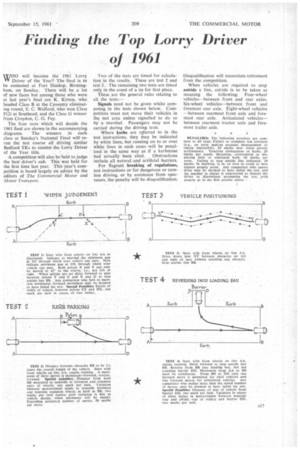Finding the Top Lorry Driver of 1961
Page 51

If you've noticed an error in this article please click here to report it so we can fix it.
WHO will become the 1961 Lorry VY Driver of the Year? The final is to be contested at Fort Dunlop, Birmingham, on Sunday. There will be a lot of new faces but among those who were at last year's final are K. Kirton, who headed Class B at the Coventry eliminating round, E. C. Walford, who won Class F(2) at Southend, and the Class G winner from Croydon, C. G. Fey.
The four tests which will decide the 1961 final are shown in the accompanying diagrams. The winners in each class at Sunday's National Final will rerun the test course all driving similar Bedford TKs to contest the Lorry Driver of the Year title.
A competition will also beheld to judge the best driver's cab. This was held for the first time last year. This year's competition is based largely on advice by the editors of The Commercial Motor and Motor Transport.
Two of the tests are timed for calculation in the results. These are test 2 and test 3. The remaining two tests are timed only in the event of a tie for first place.
These are the general rules relating to all the tests:— Signals need not be given whilst competing in the tests shown below. Competitors must not move their vehicles in the test area unless signalled to do so by a marshal. Passengers may not be carried during the driving tests.
Where kerbs are referred to in the test instructions, they may be indicated by white lines, but running on to or over white lines in such cases will be penalized in the same way as if a kerbstone had actually been sited. Obstructions include all natural and artificial barriers.
For flagrant breaking of regulations, test instructions or for dangerous or careless driving, or by assistance from spectators, the penalty will be disqualification.
Disqualification will necessitate retirement from the competition.
When vehicles are required to stop astride a line, astride is to be taken as meaning the following: Four-wheel vehicles—between front and rear axles. Six-wheel vehicles—between front and foremost rear axle. Eight-wheel vehicles —between rearmost front axle and foremost rear axle. Articulated vehicles— between rearmost tractor axle and foremost trailer axle.




































































































































